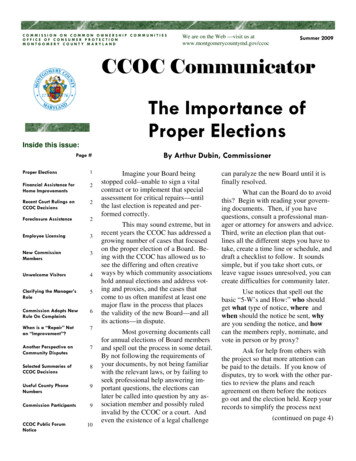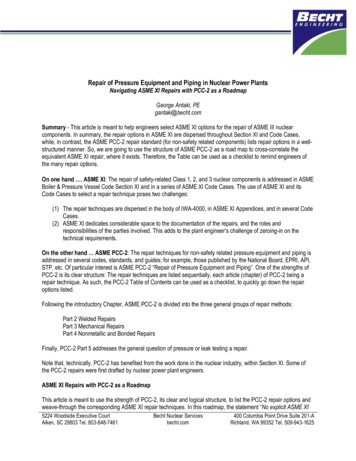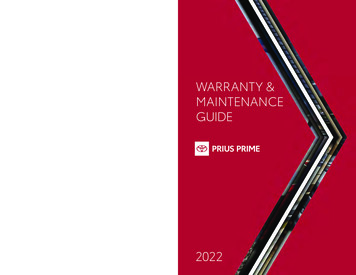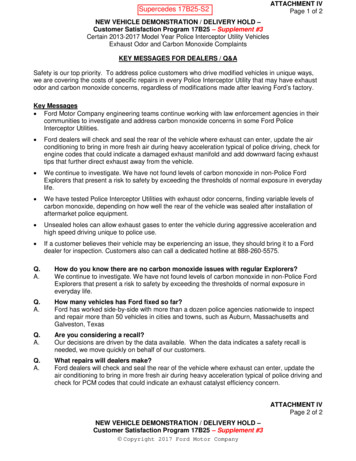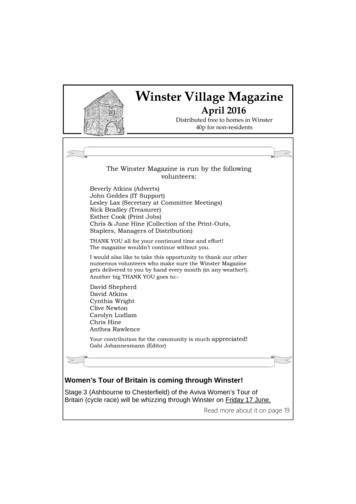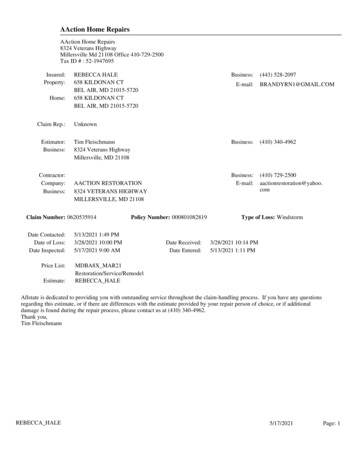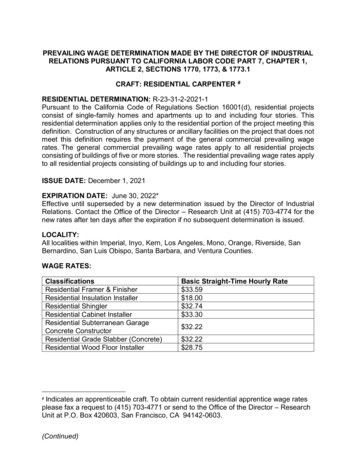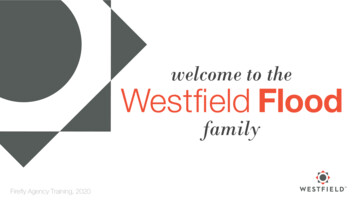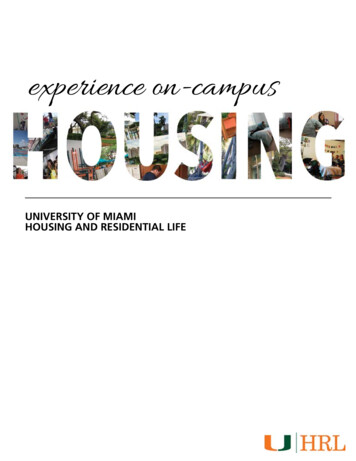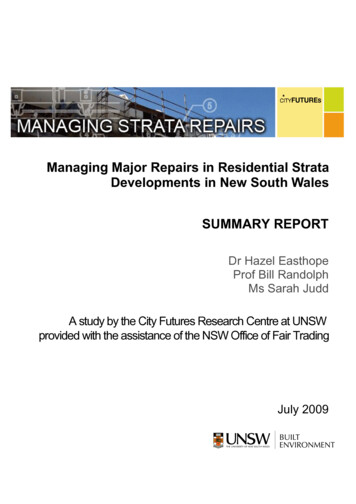
Transcription
Managing Major Repairs in Residential StrataDevelopments in New South WalesSUMMARY REPORTDr Hazel EasthopeProf Bill RandolphMs Sarah JuddA study by the City Futures Research Centre at UNSWprovided with the assistance of the NSW Office of Fair TradingJuly 2009
City Futures Research CentreCity Futures is a University Research Centre dedicated to developing a better understanding of our cities, theirpeople, the policies that manage their growth, the issues they face, and the impacts they make on ourenvironment and economy.Based in the Faculty of the Built Environment, City Futures is interdisciplinary in outlook and activity. It draws onthe skills and knowledge of those within the Faculty whose knowledge encompasses the physical and spatialaspects of urban living, as well as those in other Faculties in the University whose interests coincide with ourfocus on the city.The core activity for City Futures is research. It offers a place where scholars can pursue research on aspectsof urban development and change. But it also focuses outwards, engaging with the wider audience beyond theUniversity. Wherever possible, City Futures works in partnership with the community, government and businessto contribute to growing the evidence base on the issues that impact urban regions and how we can bettermanage their dynamic progress.City Futures will also strongly focus on the training of the nextgeneration of urban research scholars through an activepostgraduate research program. We are committed to expanding theskills and capacity of young urban researchers and to communicatingthe value of good research to those involved in making policies thatimpact on the city.Together with colleagues in other institutions who share our focusand passion, City Futures is committed to research and training thatwill contribute to better urban outcomes for Australia and beyond.AcknowledgementsWe would like to thank the NSW Office of Fair Trading for funding this project under their Property ServicesGrants funding program (file 08/22483). We would also like to express our sincere thanks to all of the strata lotowners who took the time to complete the survey. A special thank you to Nick Joannides and Eamonn Maddenfrom Partridge Partners, James Dwyer from Alexander & Dwyer Group, Robert Braid from RBA Architects andCathy Sherry from the Faculty of Law at UNSW for their expert advice. Thank you to the NSW Office of FairTrading, Jimmy Thomson, BCS Strata Management Pty Ltd. (Body Corporate Services), Hill Unit Management,Premier Strata Management Pty Ltd., North Harbour Strata Managers, and Network Strata Services for theirpromotion of the owners survey. Thank you also to Edgar Liu from CFRC for his comments on an earlier draft ofthis report.Cover montage: [Managing Strata Repairs] June 2008, Dr John BartonThis is a summary report. The full report is available resprojects/managingmajorrepairs/ City Futures Research Centre, University of New South Wales 20091
INTRODUCTIONThis document provides a summary of the findings of research carried out by the City Futures Research Centreat the University of NSW into the management of major repairs and maintenance of common property inresidential strata properties (containing three or more lots 1 ) in New South Wales. This is the first report tooutline the attitudes and experiences of strata owners towards planning for major repairs and maintenance inNSW.The project had three major aims:1. To establish current practices in respect to funding major repairs and maintenance in residential stratatitled developments through a desk-based literature and policy review.2. To explore the attitudes and knowledge of planning for major repairs and maintenance funding amongconsumers of residential strata, including resident- and investor-owners and executive committeemembers through a survey of strata owners.3. To undertake a benchmarking exercise based on data collected by strata property managers in order toestimate the types of information available on maintenance and major repairs at the block level, to identifythe form in which this information is recorded and to assess how easily the data can be accessedelectronically and analysed for trends. Based on these findings, to make recommendations on improvingmanagement data collection to enable future policy development in this area.By ‘major repairs and maintenance’ we refer to four main areas:11.Routine maintenance (e.g. clearing gutters, gardening).2.Major capital works (e.g. replacing carpets in commonareas, up-grading lifts).3.Emergency major repairs (e.g. repairing damage causedby a storm or burst pipes).4.Building defects (e.g. defects in the original construction ofthe building).Some components of the NSW strata title legislation differ for 2 lot schemes. City Futures Research Centre, University of New South Wales 20092
RESEARCH CONTEXTRepairs and maintenance are arguably the most important aspects of strata scheme management to get right.From a consumer perspective, these activities affect the lives of the thousands of people living, and investing, instrata titled properties. These properties are people’s homes, and in many cases their principal financialinvestments. However, little systematic information is available on the practices and outcomes of theseactivities.Due to its influence inAustralia andoverseas, the NSWstrata title system is anationally andinternationallyimportant case.It is also important from a political perspective. The realisation of urbanconsolidation policies in Australia’s five largest cities will rely heavily on theprovision of strata titled properties and hence the success of these policies isdirectly linked to the successful management of strata properties.Owners corporations are making vital decisions regarding the management andmaintenance of tens of thousands of residential properties, amounting to billions ofdollars in assets around Australia. There is thus a need to understand what is actually going on in the day today management of schemes, understanding what is working well and what is not, especially in regard torepairs and maintenance of common areas, so that governments and other stakeholders can consider how toimprove the situation for all those involved.Due to the historical influence of the NSW strata title legislation on other state and territory governments inAustralia as well as other countries, the NSW strata title system is a nationally and internationally importantcase study from which to address issues regarding major repairs and maintenance in multi-unit developments.RESEARCH METHODSThe research was carried out in three stages corresponding to the main aims:1. Stage 1 of the research established current practices regarding major repairs funding both in Australia andoverseas through a desk-based literature and policy review.2. Stage 2 sought to establish the attitudes and knowledge of repairs liabilities and funding methods bystrata owners in NSW through an on-line survey of strata owners. We received 244 valid responses to thissurvey, which was conducted between August 2008 and April 2009. The survey comprised respondentsfrom a variety of demographic backgrounds who owned a range of strataThe survey of strataproperties. Though consisting of only a small sample of the total populationowners comprisedof strata lot owners in NSW, the findings covered in this report can be seenrespondents from aas indicative of the range of opinions and experiences of these strata variety of demographicowners regarding the management of major repairs and maintenance in backgrounds whostrata properties. Discussion of these survey findings are supplemented owned a range of stratawith references to relevant state legislation as well as expert advice from properties.Sydney-based engineers and architects.3. Stage 3 undertook a benchmarking exercise on current management practices with regards to fundingmajor repairs based on discussions with strata management agents about the types of informationavailable on maintenance and major repairs at the block level and the form in which this data is recorded. City Futures Research Centre, University of New South Wales 20093
REPAIRS, RESPONSIBILITY, MANAGEMENT &PRACTICEIn this section, we outline common defects and commonly required repairs, as well as current practices of majorrepairs funding in NSW. We link these to the attitudes and knowledge of strata owners who responded to thesurvey.COMMON REPAIRS & MAINTENANCE PROBLEMSAlmost two-thirds of survey respondents considered the overall condition of theirbuilding to be either good or excellent, while just over one in ten respondentsconsidered it to be poor. The most common problems with building conditionidentified in the survey were non-rectified defects, and structural problems.Most surveyrespondents consideredthe condition of theirbuilding to be eithergood or excellent.Routine maintenance and major capital worksCommon problems due to age or lack ofmaintenance in residential strata schemes in NSWinclude: water ingress; water leaks in internal wetareas; failure of services; outdated balconybalustrades; blocked guttering; electrical faults;and concrete cancer.Emergency major repairsThe emergency major repairs most commonlyidentified by survey respondents also related towater ingress, as well as plumbing problems.Building defectsCommon building defects in residential strata schemes in NSW include: water ingress; water leaks in internalareas; defective services (e.g. broken lifts or air-conditioning units); defective or inappropriate design ofbalconies or balustrades; guttering faults; electrical faults; building movement; cracking to internal and externalstructures; tiling problems; various defects caused by the use of inappropriate building materials; and poor fireand safety compliance.Most survey respondentswho owned a property builtsince 1997 had ongoingdefects in their building.Of the respondents who owned a property that was built since 1997, almosttwo-thirds owned a lot in a scheme with ongoing defects in the building. Thedefects most commonly identified by survey respondents related to wateringress. City Futures Research Centre, University of New South Wales 20094
RESPONSIBILITYThere was confusion on the part of many survey respondents about Many survey respondentswere confused about who waswho was responsible for the management of major repairs andresponsible for themaintenance in their strata schemes.management of major repairsand maintenance.The owners corporation is ultimately both legally and financiallyresponsible for the management of major repairs and maintenance in their strata scheme. Should the reservesand insurances of the owners corporation not cover the full costs or any compensation awarded against themas a result of poor management of major repairs and maintenance, each owner is financially responsible for theremaining costs (proportional to their unit entitlements).Where a strata managing agent has been employed and delegated duties by the owners corporation, thatmanaging agent has a legal duty of care to ensure that the actions, omissions and statements they make in thecourse of their duties do not injure or cause harm or loss to another. Should they be negligent in their duties,they may be liable for damages.It is the responsibility of the owners corporation to ensure appropriate people are hired to carry out the majorrepairs and maintenance on their property. The owners corporation should be aware that when hiring uninsuredtradesmen, they may be financially liable for any injury experienced by that tradesman.PLANNING FOR MAJOR REPAIRS & MAINTENANCE AND MANAGEMENTOF FUNDS There are six main sources of funds that can be used for major repairs and maintenance in residentialstrata. These are: the administrative fund; the sinking fund; special levies; loans taken out by the ownerscorporation; insurances; and moneys (or other rectification) received as a result of legal action. Estimates of future spending required in a strata scheme can be made by specialist consultants, stratamanaging agents, building managers and the owners corporations themselves. There were examples of allof these amongst the survey respondents. However, some survey respondents said that no estimates hadbeen made. Levels of dissatisfaction with the way in which funds were collected in their strata schemes were highamongst survey respondents. The most common concern related to owners’ unwillingness to pay higherlevies, resulting in insufficient funds in the budget and the consequent collection of special levies. Indeed,almost a third of survey respondents indicated that major repairs and maintenance was funded by speciallevies in their scheme. The second most common concern related to aLevels of dissatisfactionlack of, or poor, planning regarding major repairs and maintenancewith the way funds werefunding and a lack of information provided to owners about these issuescollected were high.by the executive committee and/or managing agent. The majority of the survey respondents had participated in management decisions regarding majorrepairs and maintenance in their strata schemes. The most common difficulty noted by survey respondentsin making such decisions was agreement from owners over major repairs and maintenance expenditure.The next most common difficulty noted was in accurately estimating costs of future works. City Futures Research Centre, University of New South Wales 20095
Just over half of survey respondents considered that their owners corporation or managing agent hadbudgeted adequately for routine maintenance. A quarter did not think that budgeting for routinemaintenance had been Just over half of the surveyadequate in their scheme. respondents consideredThe most common reason that budgeting for routinegiven for being dissatisfied maintenance had beenwiththebudgeting adequate.undertaken for routine maintenance was that there was littlepro-active planning undertaken and that their schemesoperated on a ‘crisis management’ model. One third of survey respondents considered theirowners corporation or managing agent had not budgetedadequately for major capital works. The major concernwas the striking of special levies to cover the costs of majorcapital works. Indeed, a third of all respondents noted thatmajor capital works were often funded by special levies. Approximately one third of the 80 respondents whoanswered the question regarding the adequacy of theirsinking funds responded positively. The most commonreason given for considering their sinking fund adequatewas that a good sinking fund plan was in place. There was,however, also a common concern over the inadequacy of some sinking funds, particularly when they did notfully cover major capital works costs. There are a number of channels through which the rectification of defects in a strata scheme can befunded. These include: the owners corporation covering the costs out of the administrative or sinking fundsor through a special levy (or loan); the builder or developer covering the costs (or the costs being coveredunder home warranty insurance); taking one of a number of parties (most commonly the builder ordeveloper) to court and suing for breach of contract or negligence; and insurances held by the ownerscorporation. There were examples of all these methods currently being used by survey respondents. Afurther five respondents said that the defects would not be fixed.PUTTING THE PLANNING INTO PRACTICERoutine maintenance Approximately half the survey respondents had some concernsmaintenance was managed in their schemes. Common concernsincluded a lack of planning and of proactive leaders; the visibly poorstandard of the common property, in some cases leading to safetyconcerns; and a poor standard of work and lack of quality control inregard to completed works.regarding the way in which routineHalf of the survey respondentshad concerns about howroutine maintenance wasmanaged in their scheme.Those survey respondents who were satisfied with the way in which routine maintenance was managed intheir schemes pointed to active executive committees, contactable and responsive strata managers and/orbuilding managers, the existence of a regular maintenance schedule, good financial planning and theavailability of funds; and good reporting practices and the availability of information regarding routinemaintenance. City Futures Research Centre, University of New South Wales 20096
Major capital works Approximately half of the survey respondents had some concerns about the way in which major capitalworks were managed in their schemes. Common concerns includedHalf of the survey respondentsinadequate assessments of the nature and costs of required works,had concerns about how majorcapital works were managed in insufficient funds available to cover these costs and a poor standardof work where it was undertaken.their scheme. Those survey respondents who were satisfied with the way in which major capital works were managed intheir schemes pointed to effective budget planning resulting in sufficient funds available to cover majorcapital works; an active executive committee, including a good relationship with an active strata managingagent and/or building manager; and the fact that expert advice had been sought and acted upon.Emergency major repairs Just over a third of respondents were dissatisfied with the way in which emergency major repairs had beendealt with in their scheme. Common concerns included the length of time it took to undertake repairs, a lackof information provided to owners, a lack of consultation with owners; the effectiveness of both the stratamanager and the executive committee; and the poor standard of repairs.Stakeholders There are a number of stakeholders involved in the management of major repairs and maintenance inresidential strata schemes in NSW. These include (but are not limited to): builders, developers, real estateagents, (resident and investor) owners, the owners corporation and its executive committee, tenants, stratamanaging agents, (resident and non-resident) building managers and caretakers, contractors, andprofessional consultants (such as quantity surveyors, engineers, lawyers). A number of survey respondents noted their concern with the continued involvement of the original owner(builder or developer) in their strata scheme. In particular, concern was raised that the original owner wasmaintaining control of the executive committee and influencing the Some respondents wereactions of various stakeholders, including strata managers. It is possible concerned with thethat changes under the Strata Scheme Legislation Amendment Act 2008 continued involvement ofthe original owner.(NSW) will lead to a reduction in such concerns in the future. Almost half of the survey respondents who owned a lot in a scheme with a strata manager said that theywere dissatisfied with their strata manager’s treatment of major repairs and maintenance issues. The mostcommon complaint was that the strata manager did not provide the executive committee and/or the ownerswith sufficient information and that the agent did not respond to requests from owners and/or the executivecommittee for that information. The most common concern amongst those survey respondents who were dissatisfied with their ownerscorporation’s treatment of major repairs and maintenanceThe most common reason forissues was the amount of time taken to reach an agreement.dissatisfaction with the ownersOther concerns included harassment and inappropriate andcorporation was the amount oftime taken to reach an agreement. non-essential spending. City Futures Research Centre, University of New South Wales 20097
Almost half of the survey respondents said that they were aware of disputes between individual owners andthe owners corporation related to the management of major repairs and maintenance. Some disputesresulted from the failure of the executive committee to meet its obligations with regard to documentation,communication, obtaining quotes for needed works and the overseeing of repair works. Other disputes wereof a more personal nature, including accusations of harassment. Problems in the conduct of particular owners were also identified. These included owners interfering withhired contractors and attempting to claim moneys to improve their individual lots. Some respondents notedthat some owners had taken (or threatened to take) legal action against each other and/or against theexecutive committee regarding this issue. On the other hand, concern was also raised about the lack ofaction on the part of owners. A number of survey respondents noted disagreements in their schemes about whether certain repair ormaintenance projects were necessary. In some cases, delays due to such disagreements (or generalinaction) led to further damage to property. Disagreements often occurred when different types of ownerswithin a scheme (such as occupiers and investors; newer and older owners; shorter-term and longer-termowners) had conflicting attitudes regarding costs and standards.AVAILABILITY & COMPARABILITY OFREPAIRS & MAINTENANCE DATAExecutive committees in NSW keep a number of records relating to repairs and maintenance, including detailsof cash flow, levies and expenditures. The lack of a universal database and standardised formats for thisinformation precluded the possibility of obtaining a representative sample of relevant financial data.One potential source of information on, at the very least, ‘typical’ repairs andmaintenance costs and issues at block level are strata management firms. Theresearchers received detailed data on major repairs and maintenance funding inconfidence from three strata management companies of different sizes in NSW.While producing only a small data set, they clearly demonstrated the divergentcollection and reporting practices across strata schemes managed by differentagents. The researchers found that availability of data on maintenance and majorrepairs at block level – while often recorded in detail – is difficult to access due toissues of confidentiality and consent from individual owners corporations; a lack of standardisation in accountingcodes; and the range of software packages used by different firms to record the data. This means thatautomated comparisons between the data held by different strata managing agents is impracticable, at leastwithout extensive retrospective re-coding of accounting codes. Three possible approaches for the collation ofmajor repairs and maintenance data are outlined in Section 5 of the main report.There is no universaldatabase orstandardised formatfor executivecommittee recordsrelating to repairs andmaintenance. City Futures Research Centre, University of New South Wales 20098
DISCUSSIONThis section discusses some concerns which are beyond the scope of this research but which will requirefurther consideration in any coordinated approach aimed at improving the condition of the strata stock in thelonger-term. While the need for major repairs is strongly related to the level of maintenance that a building hasreceived throughout its life, it is also related to the design and construction processof a building. This issue was made The need for repairsapparent by the comments of is related to thesurvey respondents regarding original design andconstruction of thedefects in their buildings that hadbuilding.existed since the time ofconstruction.There are a number of factors that can contribute to defectsin a building. These include certification of component parts,training and management of contractors and subcontractorsand the potential knock-on effects of cost-cutting imperativesduring development.CONCLUSIONSThe standard of the management of major repairs and maintenance in residential strata in NSW influences tensof thousands of people living and investing in strata and underpins the success of the NSW Government’surban consolidation strategy. It is therefore important to understand what is actually going on in terms of theinterpersonal and organisational relationships that influence current practices, attitudes and knowledgeregarding planning for major repairs and maintenance. It is also important to know what the condition of thestrata stock is across the state and to get an idea of the typical costs associated with maintaining and repairingparticular types of strata properties.The survey responses indicate that common causes of concern regarding the management of major repairs andmaintenance in residential strata in NSW are:1. Ongoing building defects since construction.2. Lack of planning and of pro-active leaders.3. Inadequate assessments of required works and associated costs leading to budget shortfalls.4. A poor standard of work and of quality control where works are undertaken.The survey responses indicate that the following conditions were important for satisfaction amongst ownersregarding the management of major repairs and maintenance in their schemes:1. An acknowledgement by all owners of their responsibilities as members of an owners corporation, and asjoint owners of common property.2. An active and responsive executive committee and (where applicable) strata managing agent. City Futures Research Centre, University of New South Wales 20099
3. A good relationship (and flow of information) between the executive committee, managing agent (whereapplicable), building manager (where applicable), owners and tenants regarding plans for major repairsand maintenance.4. A regular maintenance schedule and a plan for major capital works, based on expert advice.5. Effective budget planning resulting in sufficient funds to fund required works.6. Repairs and maintenance works that are undertaken are properly funded and multiple quotes are receivedfor works before a contractor is chosen.The report also concludes that the effective management of a strata scheme is strongly influenced by therelationships between owners, between owners and the executive committee, the original owner (the builder ordeveloper), strata managers and building managers. However, the roles of the The effectivemultiple other stakeholder groups involved in the management of strata properties management of a(e.g. lawyers, engineers, the NSW Office of Fair Trading and the Consumer, scheme is influencedTrader and Tenancy Tribunal) will also need to be taken into account when by the relationshipsconsidering ways in which to improve the quality of residential strata stock in between multiplestakeholders.NSW.While the legislation covering the sector is incredibly important in governing the actions of all those involved inthe management of major repairs and maintenance in residential strata buildings, our findings suggest that inpractice, there are gaps in owners understanding of the implications of the existing legislation. There are alsolarge discrepancies between owners in terms of their knowledge regarding best practice in the sector (such asthe importance of receiving professional advice, hiring licensed contractors and drawing up regular maintenanceschedules), as well as their willingness to act inresponse to this advice. Part of the solution will be toimprove the information available to strata owners.Much information is already available on best practicein this area. NSW Office of Fair Trading, the OwnersCorporation Network and the Institute of Strata TitleManagers are some of the agencies that provide suchinformation. However, more detailed information,such as a dataset of typical costs for differentproperty types, would be beneficial in helping ownersto make informed decisions about budgeting for majorrepairs and maintenance. Three possible avenues forfurther consideration for the collection of suchinformation are suggested in the report.The other part of the solution will be to provide information to those owners who are not actively seeking it, sothat owners have this information before a problem occurs. For example, consideration could be given to thedevelopment of a toolkit compulsorily distributed to every strata owner at the time of purchase which clearlyoutlines their rights and responsibilities regarding the upkeep of the common property in their scheme.Deliberation on how best to inform owners of their rights and responsibilities regarding the management ofmajor repairs and maintenance will need to be ongoing and will of course beThe other part of thedependent on the resources available to those agencies who will provide suchsolution will be toservices. However, it is essential that this issue remain at the forefront ofprovide informationto those owners who government consideration as poor management of major repairs and maintenancein strata properties has implications for the quality of life of tens of thousands ofare not activelypeople in NSW and billions of dollars worth of assets.seeking it. City Futures Research Centre, University of New South Wales 200910
Trading, Jimmy Thomson, BCS Strata Management Pty Ltd. (Body Corporate Services), Hill Unit Management, Premier Strata Management Pty Ltd., North Harbour Strata Managers, and Network Strata Services for their promotion of the owners survey. Thank you also to Edgar Liu from CFRC for his comments on an earlier draft of this report.


